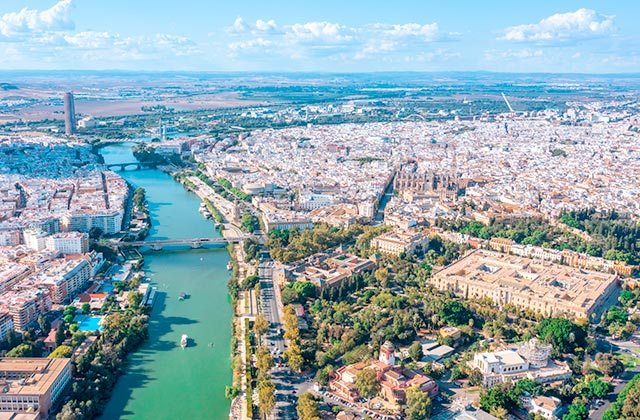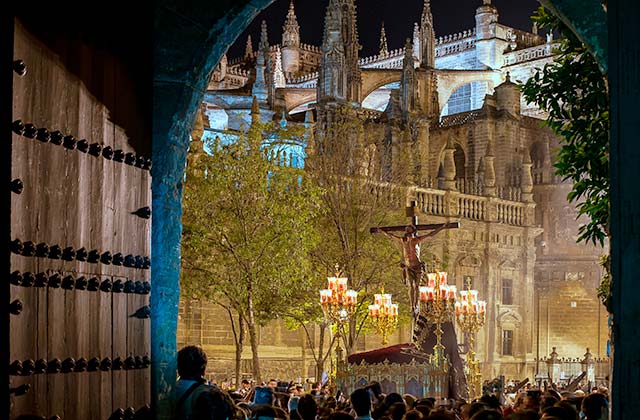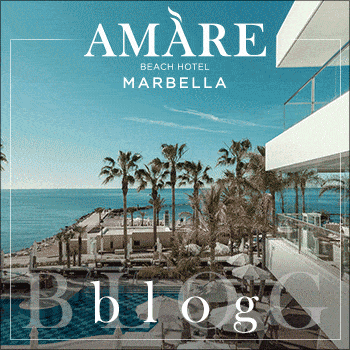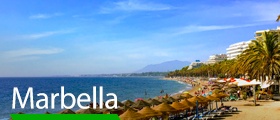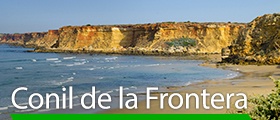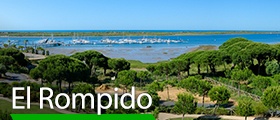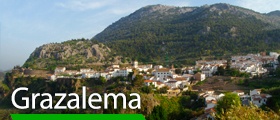
Seville: see the city of the Guadalquivir: what is there to see in one day in the capital of Andalucia?
Seville is one of the most important cities in Spain thanks to its culture and its beauty. A must-visit in Andalucia, tourists fall in love with this area due to the peculiarity of its neighbourhoods, the greatness of its monuments, the warmth of its people and the magic of its flamenco shows. Grab some paper and a pencil and note down this unique tour from Fuerte Grazalema and Fuerte Marbella where you can enjoy nature and the beach without having to give up cultural visits to the most important cities in southern Europe. We plan a route so you do not miss any of the essentials of the Guadalquivir city.
10:00 – HISTORICAL CITY CENTRE
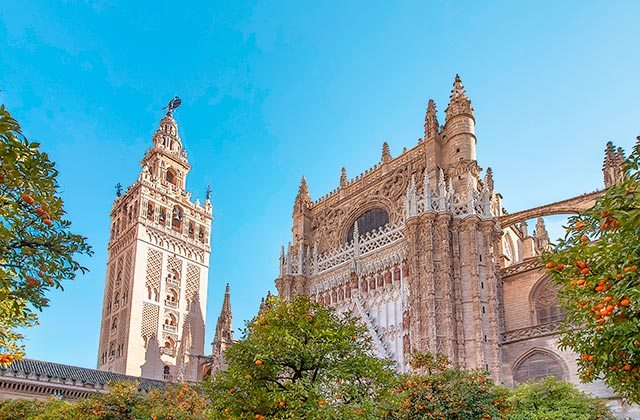
Catedral de Sevilla
Sightseeing in Seville is best done when arriving early in the city. Starting in the early morning, you can see more of its unique magic. To start, a highlight: the historical city centre, one of the largest in Spain. It is good to visit this area in the morning to be able to get into the monuments. You can leave your car in any car park and go walking.
The route starts in one of the emblems of the city, the Cathedral of Seville which is Europe’s largest Gothic example. The building was built in the fifteenth century on the ruins of the mosque, of which only the minaret is known by the name of Giralda, which is the emblem of the city, besides the Patio de los Naranjos. Here you can enjoy one of the most important Christian works of art in Andalucia and walk around its unique environment. Right next door is the Real Alcázar.
Be seduced by its gardens and mix of architectural elements which range from the Moorish, Gothic, Renaissance and Baroque.
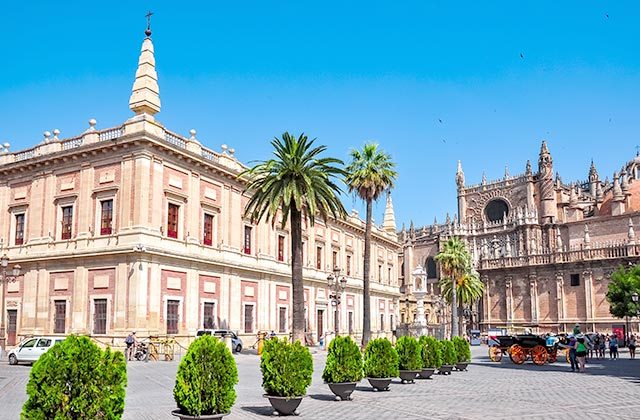
Archivo General de Indias
Continuing through the city centre, a few metres away is the Archivo General de Indias in Seville which was created in 1785 at the behest of King Charles III, in order to centralise the documents concerning the administration of the Spanish colonies. The Cathedral, the Real Alcázar and the Archivo de Indias are all considered World Heritage Sites by UNESCO.
But the monuments of Seville are only part of its charm. The entire centre is littered with craft shops where you can find typical gifts native to Andalucia. There are carriages riding down the streets and if you want you can go for a ride in the purest Sevillian style.
El Museo del Baile Flamenco, the Arab baths and the Murillo House Museum are within five minutes’ walk from the Cathedral in a circle in case if you want to see these three different folklore, relaxation or art destinations before changing location.
13:00 – BARRIO DE SANTA CRUZ

Barrio de Santa Cruz
This is one of the most important and popular neighbourhoods in Seville, corresponding with a part of the old medieval Jewry, also within the historic centre. About noon, you can come to stroll through this traditional Andalucian district with plants, flowers and streets covered with distinct types of houses. Here you have a wide range of possibilities to choose where to have lunch.
Typical Seville taverns such as the Taberna del Monte or the Bodega Santa Cruz, better known as “Las Columnas”. They are usually crowded but the customer service is very fast. You will fall in love with any snack you try.
15:00 – GUADALQUIVIR RIVER AND THE TORRE DEL ORO
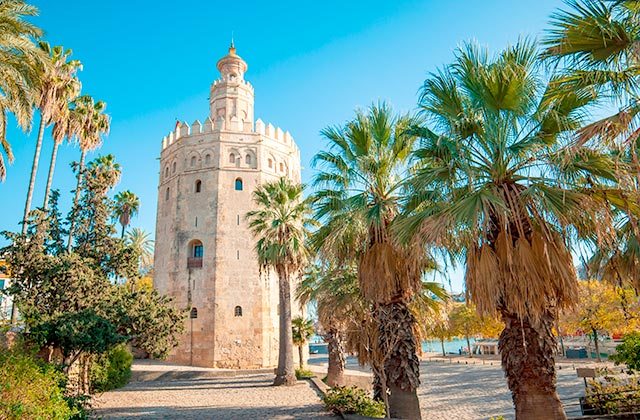
Torre del Oro, Sevilla
After lunch we suggest you head towards the river Guadalquivir to see two other major landmarks of the city: the Torre del Oro and the Real Maestranza bullring. Before we get to this destination however, we offer an excellent dessert. Halfway along the road is the tearoom La Campana. Its wonderful desserts are famous throughout the city and you should not miss it.
Once you’ve had a treat, head down to the Guadalquivir. There you will find a nice walk where you have the Real Maestranza, a traditional bullring which has played host to the best bullfighters in the history of Spain and is famous in the world of bullfighting. On the other side is the traditional neighbourhood of Triana with its inseparable Torre del Oro, a watchtower from the Almohad period with its Andalucian charm. Have a walk around the area and prepare to visit another important point of interest: the María Luisa Park.
17:00 – MARIA LUISA PARK AND PLAZA DE ESPAÑA
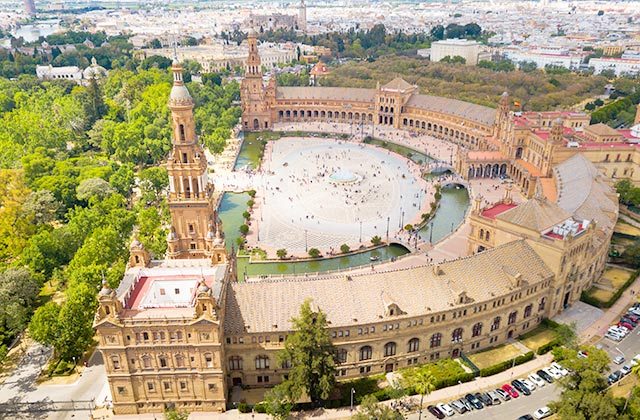
Plaza de España, Sevilla
To come to this location, you can take your car or, if you’re willing to walk, it is twenty minutes from the Real Maestranza to the María Luisa Park. You can spend time in the gardens of this spot declared a Bien de Interés Cultural which acts as the green area of the city. In the north is the Plaza de España with its Military History Museum. This place is one of the most spectacular with its regional architecture. It was built as the main building for the Ibero-American Exhibition in Seville in 1929 and its benches represent all the Spanish provinces in wall tile. It also has busts of famous Spaniards on their walls.
In the southern part is the Plaza de América with the museum of Popular Arts and the Archaeological Museum. In this plaza, a lot of pigeons gather and therefore the Park is also generally known by the nickname “Pigeon Park”.
18:00 – MUSEO DE BELLAS ARTES

Museo de Bellas Artes de Sevilla
Once you’ve relaxed in the park, go back to the car and drive to the Museum of Fine Arts in Seville. It is open until 20:30 and here you will put the finishing touch to your cultural visit. The building is one of the best examples of Andalucian mannerism. The museum’s current collection, in addition to housing Baroque treasures from Seville (with works by Francisco de Zurbarán, Murillo and Valdés Leal, among others), has been significantly enhanced by new acquisitions and important donations.
20:00 – LA CARBONERÍA
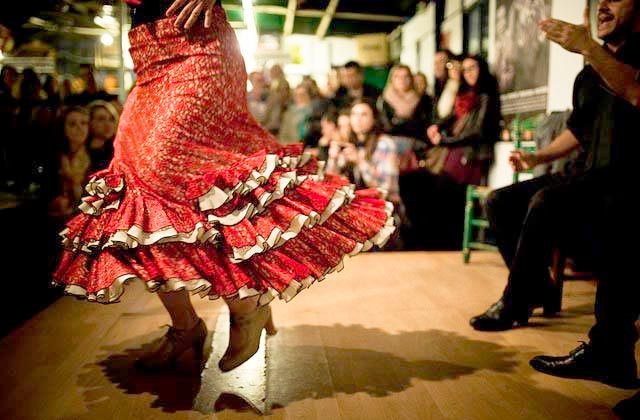
La Carboneria. Fotografía: blog.friendlyrentals.com
Before heading back, there is nothing better than enjoying the best flamenco mixed with traditional tapas. You cannot leave Seville without dining at La Carbonería. This space with its courtyard features flamenco shows that will leave you with your mouth open. Ask for Seville water (a typical drink) and some tapas to enjoy during the song and dance shows which will transport you to the depths of Andalucian folklore.
22:00 – BACK TO THE HOTEL
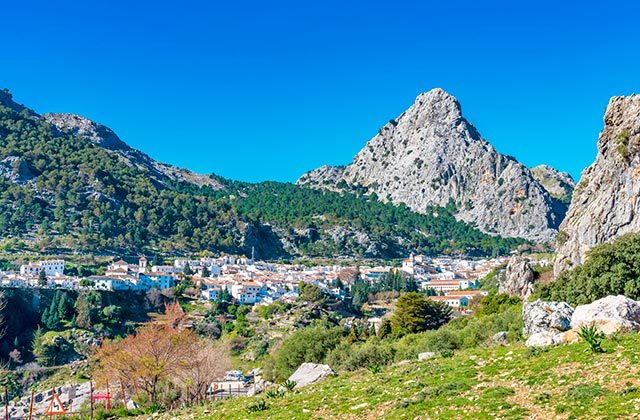
Grazalema, Cádiz
Once you’ve enjoyed this environment, prepare your things to go back to the hotel. There you can relax and unwind after this wonderful tour that will always be marked in your memory.
Fascinating Facts About the City of Seville
- The Giralda: Originally, it was a minaret of the great mosque of Seville, built during the Almohad period in the 12th century. After the reconquest of Seville by the Christians, it was converted into the bell tower of Seville Cathedral. The Giralda is a magnificent example of Islamic and Renaissance architecture.
- The Archive of the Indies: This important archive is located in Seville and houses valuable documents concerning the Spanish colonies in the Americas and the Philippines. It is a crucial resource for historians studying the period of Spanish exploration and colonisation.
- The Alcázar of Seville: This is one of the oldest palaces still in use in the world. Originally built by the Muslims in the 10th century, it has been modified over the centuries by various Spanish monarchs. The Alcázar is an impressive example of Mudéjar architecture and was declared a World Heritage Site by UNESCO along with the Cathedral and the Archive of the Indies.
- Plaza de España: Designed for the Ibero-American Exposition of 1929, the Plaza de España is a monumental architectural complex that mixes elements of the Renaissance and Spanish Baroque. The square is famous for its semi-circular canal where visitors can rent boats, and its benches decorated with tiles that represent the provinces of Spain.
- Flamenco: Seville is considered one of the cradles of flamenco, an art form that combines singing, dancing, and music, and is an essential part of Andalusian culture. The city has numerous “tablaos” flamenco venues where visitors can enjoy passionate performances.
- The April Fair: Seville is famous for its April Fair, a celebration that takes place approximately two weeks after Holy Week. The fair transforms the city into an explosion of colour, music, and dance, highlighting flamenco and traditional Andalusian attire.
- Holy Week: The celebration of Holy Week in Seville is one of the most impressive and moving in all of Spain. During this week, the city is filled with religious processions, where brotherhoods wear traditional costumes and carry floats (large platforms with religious figures) through the ancient streets. The devotion and artistry displayed attract visitors from around the world.
- Itálica: A few kilometres from Seville is the ancient Roman settlement of Itálica, founded in 206 B.C. Itálica is notable for its well-preserved mosaics and for being the birthplace of two Roman emperors, Trajan and Hadrian.
- The University of Seville: Founded in 1505, it is one of the oldest universities in Spain and an important centre for higher education and research. Its library houses many ancient manuscripts, books, and documents, some of which date back to the time of the Reconquista.
- Patios and Gardens: Seville is famous for its internal patios and gardens, many of which can be found in the old town of the city. These spaces offer a refuge from the summer heat and are a testament to the importance of the outdoors and nature in Andalusian culture.
- Arab Influence: Seville was an important cultural and political centre during the period of Al-Andalus, and the Arab influence is evident in its architecture, art, and gastronomy. The Alcázar is a standout example, but there are many other buildings and neighbourhoods throughout the city that reflect this rich heritage.
ACCOMMODATION
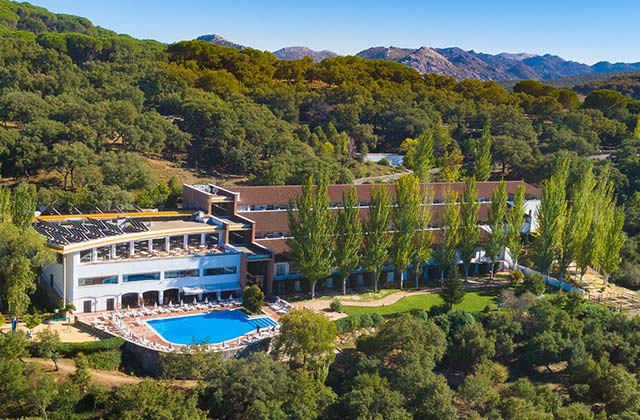
Hotel Fuerte Grazalema
Fuerte Hoteles is always the best option to stay in Andalucia, see its cities and rest. The chain has branches where you can enjoy the best of each area throughout the region, in addition to its services. With more than 60 years of experience, this is the best guarantee and the starting point for each experience except you want to undertake in the region. Fuerte Grazalema and Fuerte Conil-Resort are two of these magnificent lodging options from which you can make your trip to Seville.

